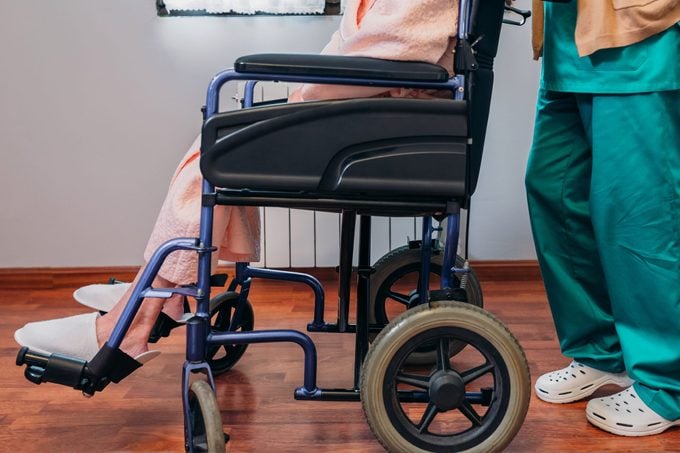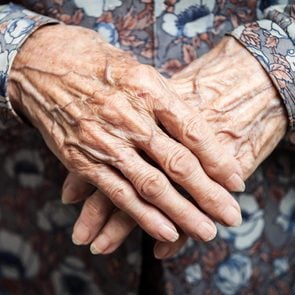8 Signs It’s Time for Hospice Care
Updated: Mar. 14, 2022
Choosing hospice can be difficult and scary—but waiting too long means missing out on important comfort measures. Here are expert insights about when, and how, to transition to hospice care.
Hospice care basics
There’s a common misconception that choosing hospice care means giving up hope. It may seem like a last resort; as though opting for hospice means a patient has lost the will to live.
Hospice does focus on comfort rather than cure, according to Jeffrey Landsman, MD, at Mercy Medical Center in Baltimore. But for many patients, this shift unlocks a higher quality of life.
To help you understand when it’s time to choose hospice, we asked Dr. Landman and former registered hospice nurse Jennifer Prescott, who now runs Blue Water Homecare in Leander, Texas, to weigh in.
What is hospice care?

Hospice helps people who are terminally ill live comfortably, according to the Center for Medicare & Medicaid Services. In other words, hospice care involves treating symptoms rather than curing disease—and, according to Prescott, it allows for a more comfortable, dignified death.
Hospice care is also a specific Medicare benefit, explains Dr. Landsman. Hospice care covered by the Medicare Hospice Benefit (MHB) may include:
- Nursing services at home
- Essential medical equipment (walker, wheelchair, etc.) and supplies (bandages, catheters, etc.)
- Prescription drugs not intended to cure the terminal illness
- Grief counseling for caregivers and family members
- Respite care (short-term help that allows family caregivers to rest)
“Keep in mind that hospice is a service, not a place,” says Prescott. This means a patient can receive their care where it’s most suitable for their needs, whether that means at home, in a hospital, or within a skilled nursing facility.
Who can access hospice care?
“The patient has to have a certain diagnosis to qualify for hospice,” says Dr. Landsman. That can be cancer, dementia, heart disease, or another condition that’s been diagnosed as terminal. But, he adds, “There are specific criteria someone has to meet.” The primary qualifications for hospice care are these two factors:
- having less than six months to live (as determined by a doctor)
- for the purpose of symptom management, instead of disease reversal
Prescott adds that hospice benefits do not include medical services or medications to reverse the disease.
8 signs it’s time for hospice care
Choosing hospice may not be easy. But if someone you love is dying, hospice can help to ease their pain and improve the experience of this period of their life—for them, and possibly for you, too.
If you’re wondering whether you both might gain support from a professional caregiver who’s trained to manage a patient through terminal illness, here are the signs it may be time to consider hospice care.
A less than six-month life expectancy
Doctors do their best to project how terminal illness will unfold, but this is often not an exact science. In fact, Dr. Landsman says there have been times when “people get enrolled in hospice and . . . live for years.”
Prescott says this can be because modern medical developments—like ventilators and artificial nutrition, for instance—can improve a patient’s life expectancy. Still, she says, hospice can be an appropriate consideration when you face “an inability to cure or maintain a disease.”

Frequent emergency room visits or hospitalizations
When a loved one has tumbled into a cycle of emergency room visits, it may be time to talk about hospice care.
“Sometimes you see someone get hospitalized over and over again for the same thing. And they get to the point that they don’t want to go to the hospital anymore. They’re tired of it,” explains Dr. Landsman. “When [they don’t want to] continue… that’s when it’s time.”
Recurrent or resistant infections
As a person’s body succumbs to disease, infections often occur more frequently. Pneumonia and urinary tract infections (UTIs) are especially common at the end, according to the National Institute on Aging. So if someone with a terminal illness can’t seem to shake an infection, it might be time for hospice.
It’s important to know that a hospice doctor can choose to halt antibiotic treatment. Why? A survey published in the International Journal of Infectious Diseases indicates that though using antibiotics at the end of life might prolong suffering—however, many doctors will still prescribe them to help treat a patient’s symptoms and discomfort.
Frequent falls
This is particularly pertinent for aging populations. If your elderly loved one has fallen often during the past six months, pay attention. Even falls that don’t result in injury can trigger anxiety and stress that can make caring for the patient even more emotional for their family.
Frequent falls alone are probably not a reason to choose hospice care. But if someone qualifies for hospice with a serious illness and short life expectancy, a series of falls may signal a need for in-home care or support in another setting.
Dramatic weight loss or loss of appetite
Weight loss is a common red flag if other signs indicate that it may be time for hospice. “If someone with dementia isn’t eating much, if they’re losing weight, those are the signs,” Dr. Landsman says.
Prescott emphasizes that this is not intentional weight loss—instead, it’s the result of loss of appetite, among other things. In fact, “nutritional impairment” is one of several possible criteria for the Medicare Hospice Benefit (MHB), per the U.S. Centers for Medicare & Medicaid Services.
Uncontrolled pain or discomfort
Sometimes, treating a condition can be painful. As just one example, Riluzole—a medication used to treat amyotrophic lateral sclerosis (ALS)—can cause swelling, dry mouth, and sleep problems. Chemotherapy can trigger nausea, diarrhea, hair loss, and other side effects.
Sometimes a cure is also not possible. Whether extreme discomfort is from disease-reversing medications or the disease itself, uncontrollable pain can signify that it’s time to choose hospice.
“The hospice team focuses on … managing symptoms at end of life, such as pain, shortness of breath, and decline in physical or cognitive functioning,” says Prescott.
Confusion or restlessness
For a patient to experience agitation, confusion, and feeling fidgety or uncomfortable in one position can indicate “the pre-active dying phase,” according to a 2013 article published in The Pharmaceutical Journal that also suggests 25 to 85 percent of patients in the final stage of their lives experience these symptoms.
It’s distressing to see someone you love grow confused or agitated. Even more difficult is the fact that these symptoms can sometimes indicate respiratory failure (low oxygen and/or high carbon dioxide levels). These are likely signs that it’s time to call the doctor—and possibly to choose hospice.
Extreme drowsiness
Lack of oxygen or organ shutdown can also cause extreme drowsiness. End-of-life changes in consciousness might be difficult to pinpoint if your loved one has been sick for a long time, especially with an illness related to their memory or cognition. However, any significant changes in a terminally ill person’s energy or wakefulness may warrant a call to the doctor.
When drowsiness is accompanied by other signs on this list, it could time to consider hospice.
How to know when the time is right
If someone in your life qualifies for hospice care, there may be no wrong time. This deeply personal decision is one you can explore with any loved one whose health is significantly declining.
While, according to the National Hospice & Palliative Care Organization, more than 50 percent of hospice patients die within 30 days of enrolling in hospice care, understand that’s rarely a reflection of the quality of care. Instead, it may show that most terminally ill patients could have enjoyed the benefits of hospice sooner.
“Most people—family members and patients—are extremely satisfied and feel they get great benefits from their hospice services,” says Dr. Landsman. “A lot of people say they wish they’d done it sooner.”
When patients and caregivers avoid hospice until the final days, they may miss out on comfort measures, peaceful moments with their ailing loved one, comforting friendships with hospice nurses, and respite and grief support for the family.
How to transition to hospice care
If you’re ready to choose hospice, these are your next steps.
Research hospice providers in your area
You can ask your doctor for recommendations or search online for well-reviewed companies in your region. Prescott recommends calling around and asking the following questions to provider representatives:
- How often do your nurses visit?
- How often do your nurse aides visit?
- Do you offer extra therapies such as music, massage, or pet therapy?
- If needed, is physical therapy an option for a short time?
- Can the patient keep the same type of equipment they are already using?
- Which specific medications are covered?
Make the request
“Almost anybody can call in a referral for hospice,” says Dr. Landsman. Patients, family members, caregivers, and doctors can all request an evaluation for hospice enrollment.
Of course, switching to hospice is ultimately the patient’s decision, as long as they possess the capacity to communicate this.
Complete an evaluation
After submitting a request, often through the patient’s primary care provider, a nurse or other professional will consult with the patient and family to evaluate whether the patient meets the criteria for entering hospice care.
Begin hospice care
It’s not always easy to think about making the shift to focusing on comfort instead of a cure. Be open with your hospice team about any concerns or questions you have as care begins.
What to expect
Hospice care typically occurs at home, where you can expect to welcome a visiting nurse two or three times per week or more. The frequency of visits depends on the patient’s needs.
Also, the caregiver is typically there to administer medications, offer the patient a bath, and take care of other tasks that may be difficult for a loved one to manage. “It’s not 24-hour care, which I think people get confused about sometimes,” says Dr. Landsman.
One of the most meaningful aspects of hospice is how the team works with the whole family. Hospice helps family caregivers with respite and grief counseling while offering the dying loved one compassionate, hands-on care.



















